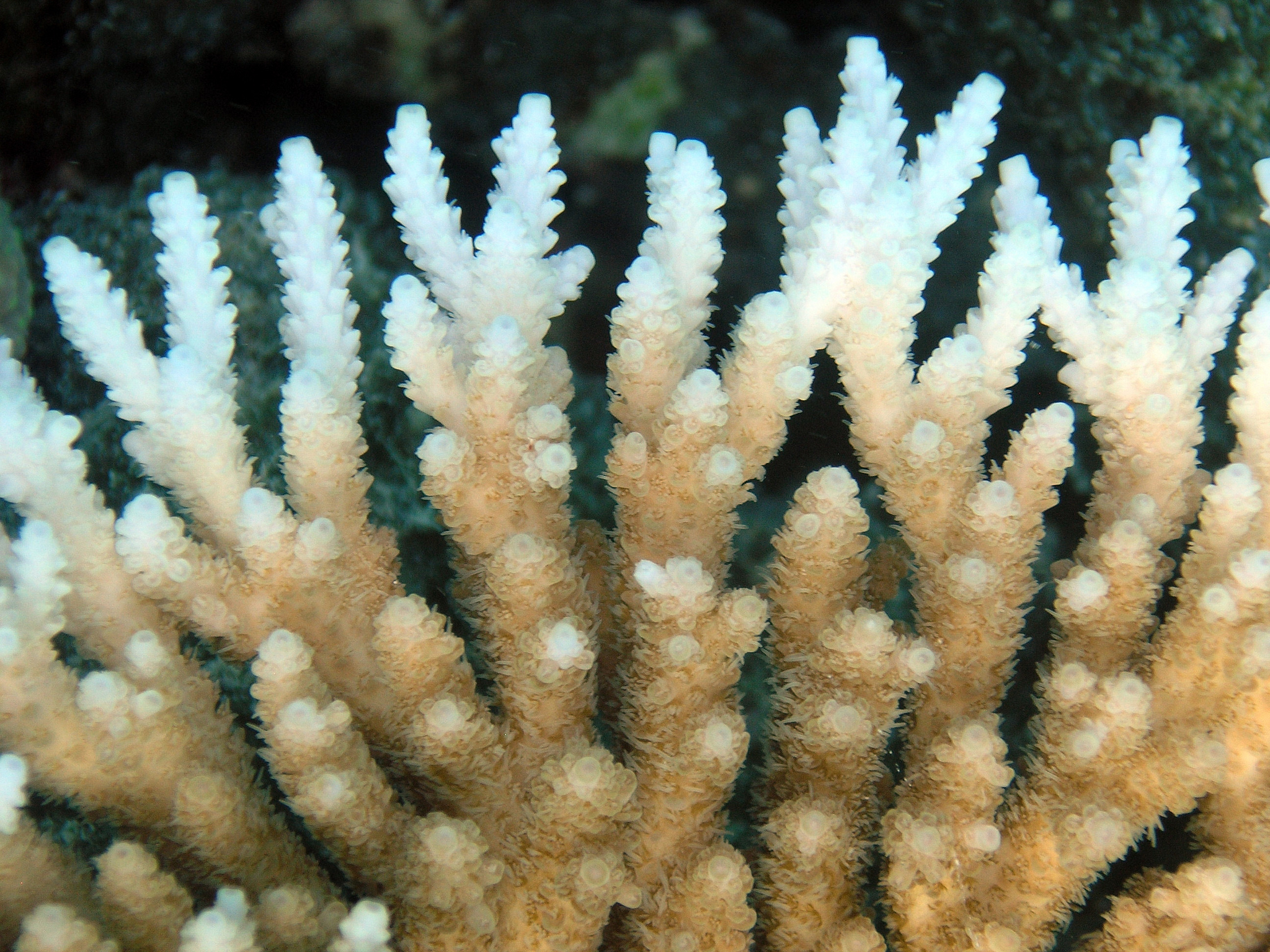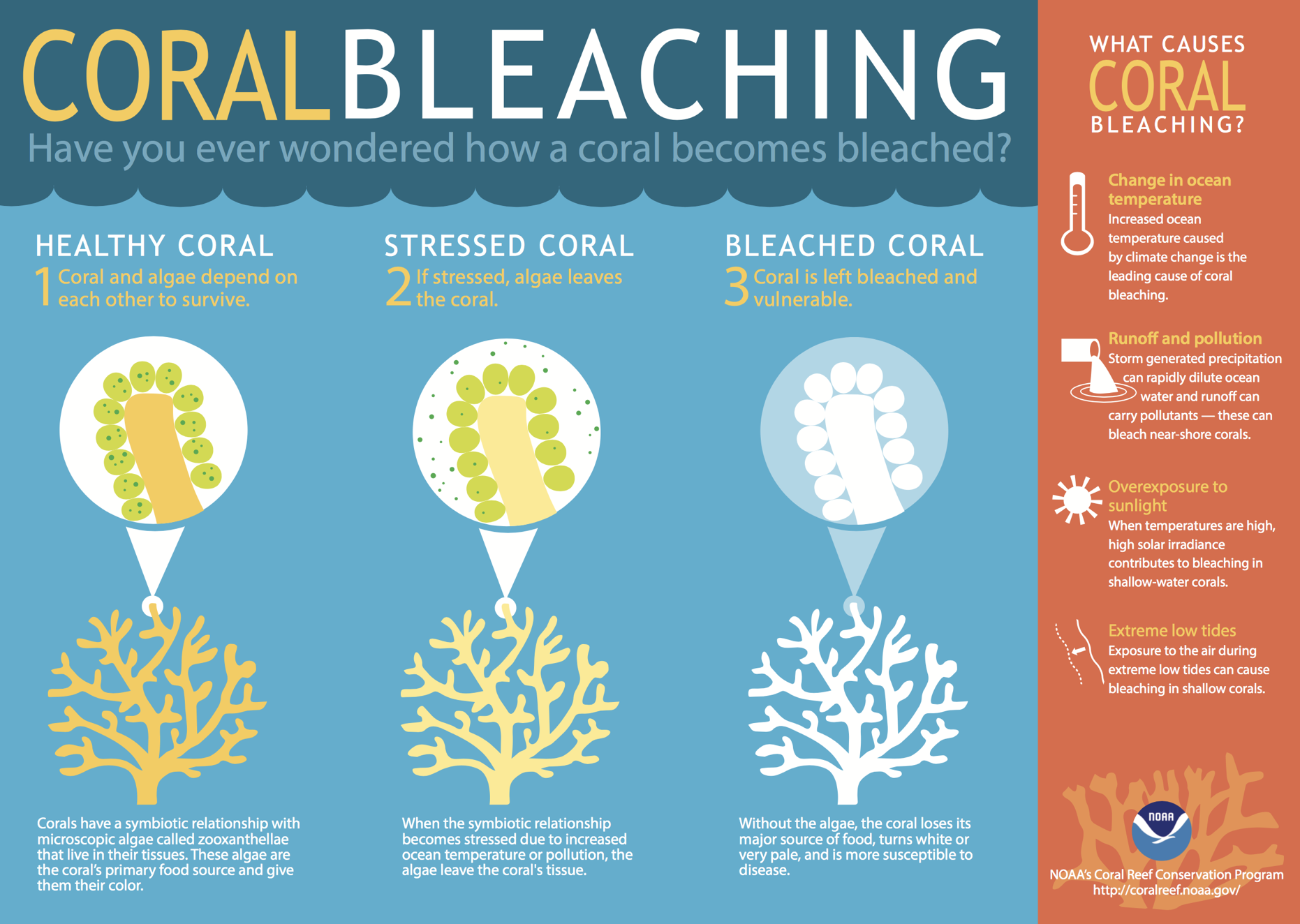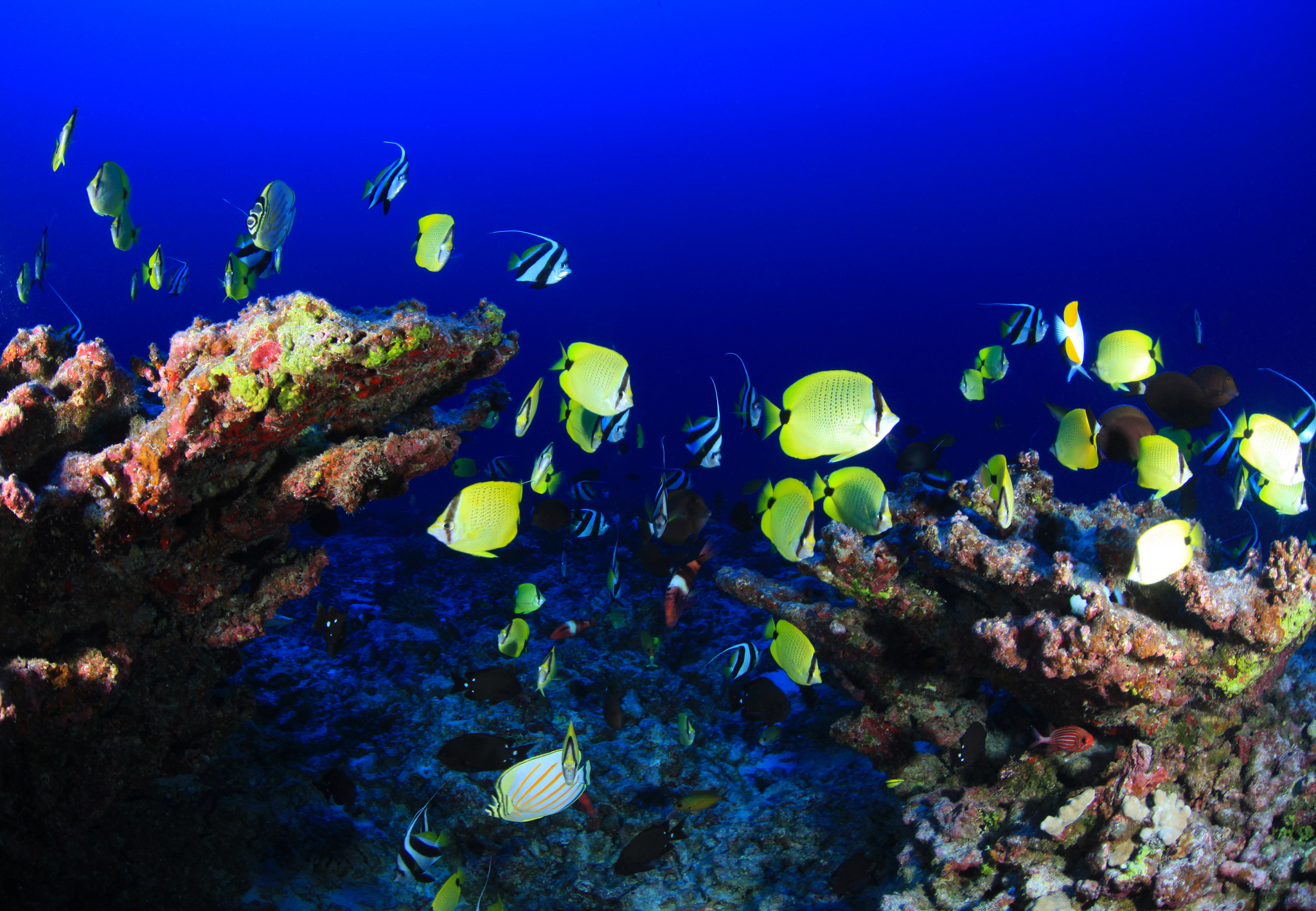Pollution
3.4 Impacts of Cyanide Fishing on Coral Bleaching Events
Mitchell J. Johnson
Corals play a pivotal role in marine ecosystems, as well as, impact humans in significant ways. These marine species face threats as temperatures rise, and humans utilize fishing techniques that stun fish and release harmful chemicals into the oceans. Will cyanide continue to be problematic for corals or will new research lead to alternative fishing practices?

Corals are marine animals whose polyps form endosymbiotic relationships with algae in the genus Symbiodinium.5 These dinoflagellates, known as zooxanthellae, are critical to coral health as they photosynthesize and provide energy in the form of sugars.2 Coral bleaching is a process whereby the coral expel their algal symbionts to increase their chances of survival, resulting in discoloration of coral colonies (Figure 1).2 The algae can be replaced, but the coral will die soon after the event if they do not acquire new algae.4
Corals play a pivotal role in marine ecosystems. They provide shelter and substrate for many different species of fish and invertebrates. Furthermore, their impact on humans is significant. Coral reefs mitigate damage to beachside properties by damping waves, which would otherwise erode the beach. In addition, coral reefs are estimated to provide billions of dollars in revenue through fishing, biomedicine, and tourism.4 As such, maintenance of coral reefs is critical in oceanic conservation.

Three major stressors are commonly evaluated pertaining to coral bleaching events. Firstly, rapid warming of oceans is often cited as the major factor contributing to massive coral bleaching events.3,4,5 As temperatures rise, corals expel their endosymbionts. El Nino occurrences, a major trigger of previous bleaching events, are expected to increase in frequency as global temperatures increase.2 This could elicit drastic changes in conditions which corals may not be able to withstand. Blast fishing may also negatively affect corals. Blasting involves stunning fish with explosives in order to make them easier to capture.10
Potassium nitrate is often used in local communities as a cheap method for producing desirable explosive effects.10 This process often results in fragmented corals originating from the source of the explosion and can have significant impacts on reef health.10 Finally, cyanide fishing is a common practice where cyanide is used to stun fish and make them easier to capture.1,2,3,6,8,9,10,11 It can also kill fish which cannot tolerate higher doses used to stun larger fish. About 70% of fish caught for aquariums are captured using sodium cyanide.3 It is illegal in many countries but is still widespread in regions lacking regulations.9 Cyanide may trigger local bleaching events by inhibiting photosynthetic activity of the Symbiodinium.1,5,7,8
There is a substantial amount of research underway investigating the impacts of the aforementioned stressors. In particular, many researchers are interested in learning how chemical stressors may impact coral health. Much of the research referenced focuses on cyanide’s impact on hard corals and their endosymbiotic dinoflagellates. In one experiment, researchers exposed corals to varying concentrations of cyanide ion.1 These concentrations were lower than those typically used by fishing operations.1 Corals responded by expelling their zooxanthellae. Analysis of the data described the reduced density of zooxanthellae and increased cellular division of zooxanthellae for groups exposed to cyanide.1 Some of the dinoflagellates exposed to cyanide died, while others appeared discolored.1 These results demonstrate the severe impacts cyanide may have on photosynthetic activity and coral health.1
Similar experiments support these results and have shown that cyanide specifically inhibits the Calvin cycle of photosynthesis in dinoflagellates.5,6,7,8 Concentrations for these experiments were carefully selected to find the level of cyanide which inhibits the Calvin cycle but does not affect other processes in either organism.5,6,7,8 In addition, some findings do not support the hypothesis that thermal stress alone can inhibit the Calvin cycle.8 Other research has shown that cyanide has a significant impact on the coral itself as well as other organisms which are exposed to high concentrations. Evidence suggests that cyanide inhibits mitochondrial activity, and therefore reduces availability of ATP (adenosine triphosphate) in cells.3 Together, this data presents a legitimate concern for coral health where cyanide is used. Both corals and their dinoflagellate symbionts are adversely affected by cyanide, which may exacerbate bleaching events.
Figure 3. Alternative fishing techniques can be detrimental to aquatic species, such as the coral in coral reefs. Blast fishing utilizes explosives underwater to stun fish, making them easier to catch. Sodium cyanide is often used in a practice known as cyanide fishing in which fish are stunned with the substance and are then easier to capture for use in aquariums. Major factors contribute to major coral bleaching events such as in specific areas of the Great Barrier Reef in Australia. Courtesy of Drajay1976, 2013, Wikimedia Commons. CC BY-SA 3.0., Ella Weaver, 2017., and Oregon State University, 2016, Wikimedia Commons. CC BY-SA 2.0.
Researchers are searching for more pragmatic approaches to addressing cyanide fishing because it is difficult to regulate. One proposal is the use of clove oil in fishing operations.4 Clove oil causes fish to lose consciousness and may serve as an alternative to cyanide.4 In a study exposing corals to varying concentrations of clove oil solution, researchers found that low concentrations were not harmful to the coral used in the experiment.4 In contrast, low concentrations of cyanide were found to be significantly damaging.1 Thus, clove oil may be a viable alternative in the fishing industry because it does not have a significant ecological impact on local coral populations.4
Besides alternatives to cyanide fishing, it is important to develop new techniques which allow for detection of cyanide when it is used illegally.9,11 This two-pronged approach may offer an alternative while providing punishment for those who do not cease illegal activities. One of the ways to do this is through detection of thiocyanate anion, which is excreted by marine fish after they neutralize cyanide ion.11 Optical fiber is used in addition with liquid chromatography technology to detect thiocyanate.11 This new technique could be used for detecting aquarium fish which have been caught illegally and consequently would eliminate the benefits of using cyanide in fishing practices.11
In addition to mechanical methods of detecting cyanide, several biological methods exist. Bacteria are capable of metabolizing cyanide ion and converting it to cyanate through the use of oxygen.9 As more cyanide is degraded, oxygen levels decrease.9 Decreasing oxygen levels can be monitored using Clark oxygen electrodes, which would indirectly measure cyanide levels in seawater.9 Other biosensors utilizing properties of enzymes have been proposed for detection of cyanide, and can often provide precise measurements of cyanide concentrations.9

While there is still a need for more research concerning the causes of coral bleaching events, the effects of cyanide on corals are becoming well understood. Highlighting this cause allows for policies to address cyanide fishing through new methods of detection and screening of aquarium fish in countries with the infrastructure to do so. An understanding of the physiological impact cyanide has on corals and marine life will also allow for a broader view of toxicology of trophic levels within ecosystems. As more research highlights the impact of warming temperatures on coral bleaching, it is critical that more easily addressed issues are resolved to relieve local coral populations from some of these pressures.
References:
- Cervino, J.M., et al. (2003). Changes in zooxanthellae density, morphology, and mitotic index in hermatypic corals and anemones exposed to cyanide. Marine Pollution Bulletin, 46(5):573-586
- Coral Health and Monitoring Program. Coral Bleaching – Background. National Oceanic and Atmospheric Administration (NOAA). Retrieved from http://www.coral.noaa.gov/research/climate-change/coral-bleaching.html
- Downs, C.A., et al. (2010). In vitro cell-toxicity screening as an alternative animal model for coral toxicology: effects of heat stress, sulfide, rotenone, cyanide, and cuprous oxide on cell viability and mitochondrial function. Ecotoxicology, 19:171-184
- Frisch, A.J., et al. (2007). The effects of clove oil on coral: An experimental evaluation using Pocillopora damicornis (Linnaeus). Journal of Experimental Marine Biology and Ecology, 345(2):101-109
- Hill, R., et al. (2014). Inhibition of photosynthetic CO2 fixation in the coral Pocillopora damicornis and its relationship to thermal bleaching. Journal of Experimental Biology, 217:2150-2162
- Jones, R.J. (1997). Effects of cyanide on coral. SPC Live Reef Fish Information Bulletin, 3: 3-8
- Jones, R.J., & Hoegh-Guldberg, O. (1999). Effects of cyanide on coral photosynthesis: implications for identifying the cause of coral bleaching and for assessing the environmental effects of cyanide fishing. Marine Ecology Progress Series, 177:83-91
- Jones, R.J., et al. (1999). PAM Chlorophyll Fluorometry: a New in situ Technique for Stress Assessment in Scleractinian Corals, used to Examine the Effects of Cyanide from Cyanide Fishing. Marine Pollution Bulletin, 38(10):864-874
- Mak, K.K.W., et al. (2005). Cyanide fishing and cyanide detection in coral reef fish using chemical tests and biosensors. Biosensors and Bioelectronics, 20(12):2581-2593
- McManus, J.W., et al. (1997). Effects of Some Destructive Fishing Methods on Coral Cover and Potential Rates of Recovery. Environmental Management, 21(1): 69-78
- Vaz, M.C.M., et al. (2012). Excreted Thiocyanate Detects Live Reef Fishes Illegally Collected Using Cyanide—A Non-Invasive and Non-Destructive Testing Approach. PLoS ONE, 7(4): e35355
Figures:
- Drajay1976. (2013). [Photograph of explosive going off underwater]. Retrieved from Wikimedia Commons. CC BY-SA 3.0.
- NOAA National Ocean Service. (2011). [Photograph of healthy coral reef]. Retrieved from FlickrCommons. Public Domain.
- Oregon State University. (2012). [Photograph of close up coral bleaching]. Retrieved from FlickrCommons. CC BY-SA 2.0.
- Oregon State University. (2016). [Photograph of mass bleaching event]. Retrieved from Wikimedia Commons. CC BY-SA 2.0.
- Weaver, Ella M. (2017). [Graphic of Sodium Cyanide].
- What is coral bleaching? (2017). National Oceanic and Atmospheric Administration. [Coral reef infographic]. Retrieved from http://oceanservice.noaa.gov/facts/coral_bleach.html.
